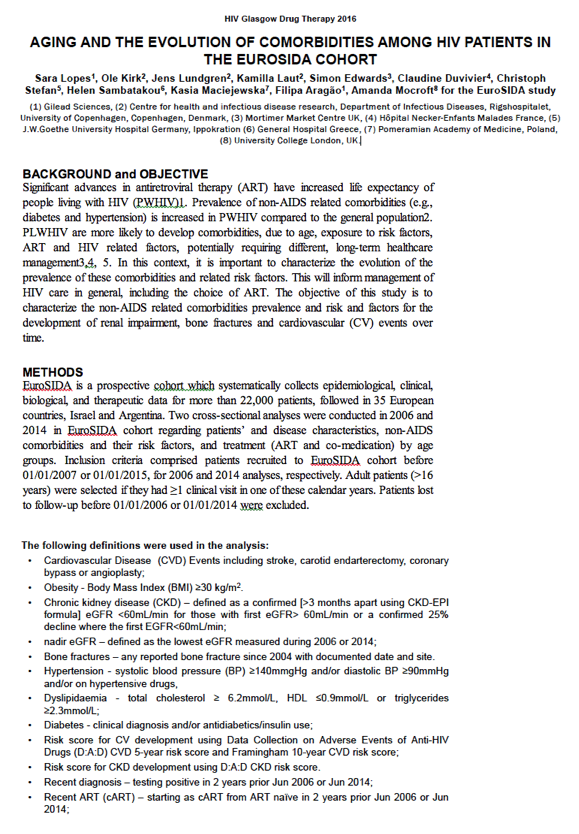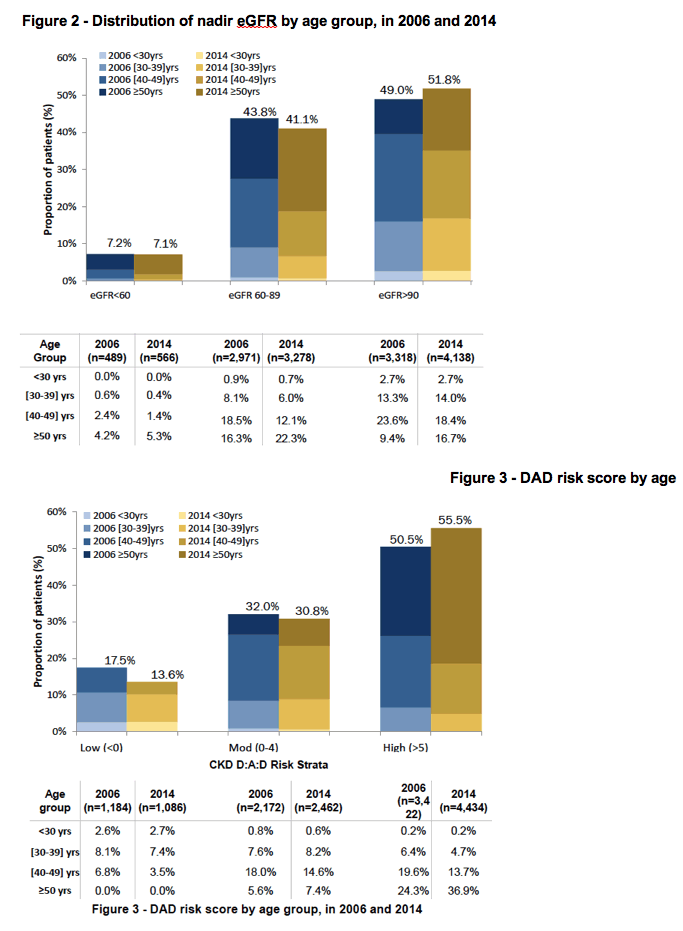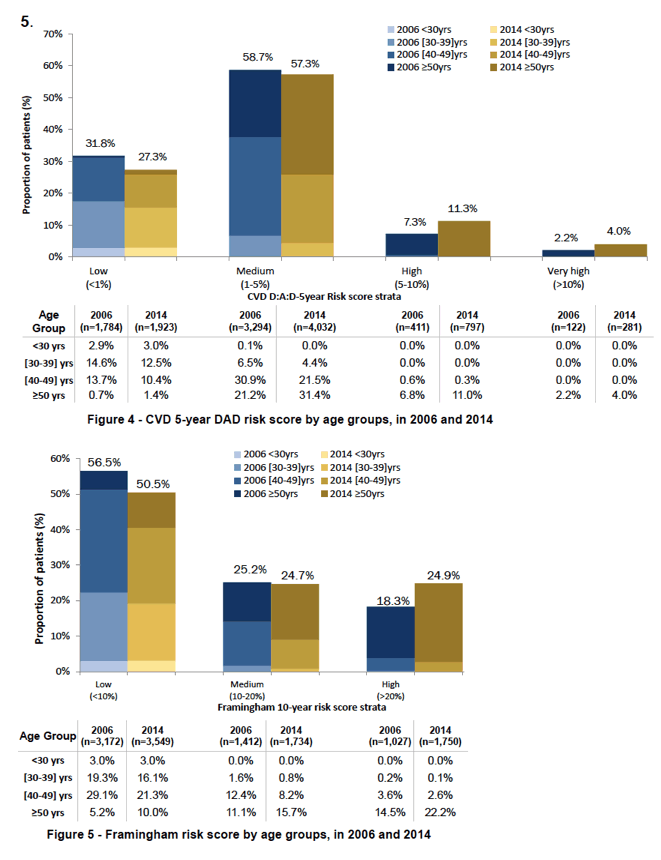 |
 |
 |
| |
Rates of All Age-Related Comorbidities Rise in EuroSIDA From 2006 to 2014
|
| |
| |
HIV Drug Therapy, Glasgow Oct 23-26 2016
From Jules: look at Figure 1 immediately below - you will see doubling of kidney disease, fractures & big increase in hypertension when comparing patients >50 years old to unclear what the comparison is but appears to be overall for all patients. AND most importantly this does not look only at patients over 65 to 75 where we would be likely to see bigger increases. .....Look at Figure 2 below and you will see from 2006 to 2014 almost a doubling of low 2GFR for patients >60 from 9.4% in 2006 to 16.7% in 2014.....In Figure 5 you will see big increases for patients >50 for CVD 5 year DAD risk score & for Framingham risk score too from 2006 to 2014.

"There was an increase of 5.0% of patients in renal DAD high risk group. This is particularly observed for patients ≥50 years which increased from 24.3% in 2006 to 36.9% in 2014, in the high risk group - Figure 3......
†The CVD 5-year DAD risk score show an increase in the proportion of patients with high or very high risk groups (from 9.5% in 2006 to 14.3% in 2014 for both groups), which was almost exclusively due to patients aged ≥50 years -Figure 4.†
In 2014 overall proportion of patients with Framingham 10-year cardiovascular high risk score increased by 6.6% compared to 2006. This was particularly evident among those aged >50 (14.5% vs. 22.2%) - Figure 5.†"
"....Prevalence of non-AIDS related comorbidities (e.g., diabetes and hypertension) is increased in PWHIV compared to the general population2. PLWHIV are more likely to develop comorbidities, due to age, exposure to risk factors, ART and HIV related factors, potentially requiring different, long-term healthcare management....it is important to characterize the evolution of the prevalence of these comorbidities and related risk factors"
Mark Mascolini
Prevalence of cardiovascular disease (CVD), chronic kidney disease (CKD), fractures, and all other comorbidities assessed rose from 2006 to 2014 in a large EuroSIDA cohort analysis [1]. Rates of dyslipidemia and hypertension were particularly high in people 50 or older.
The aging of HIV populations and the attendant growing risk of age-related comorbidities are no news to those involved in HIV care and to aging HIV patients themselves. Researchers working with EuroSIDA, a prospective observational cohort study in Europe, Israel, and Argentina, aimed to chart changes in age-related comorbidities in cohort members by comparing two cross-sectional analyses--one in 2006 and one in 2014.
Cohort members could enter the analysis if they were 16 or older and made 1 or more clinical visits in 2006 or 2014. The researchers assessed age-standardized prevalence of several comorbidities and risk factors in the overall group in each year and among cohort members 50 and older. They defined CKD as an estimated glomerular filtration rate below 60 mL/min in two measures more than 3 months apart. Diabetes meant a clinical diagnosis or use of antidiabetic agents. They also assessed changes in smoking, obesity, and D:A:D CVD and CKD risk scores.
The analysis focused on 9554 people in 2006 and 11,504 in 2014. The proportion of people 50 or older rose from 25.2% in 2006 to 44.0% in 2014. Respective proportions of men were 73.6% and 71.9% and of Caucasians 87.0% and 88.4%. The proportion of overweight people (body mass index 25 to 29.9 kg/m2) rose from 21.0% in 2006 to 23.6% in 2014, while the proportion of obese people (body mass index 30 kg/m2 or higher) climbed from 4.3% to 6.4%. The proportion of current smokers fell slightly from 31.7% in 2006 to 29.6% in 2014, while the proportion of past smokers jumped from 7.2% to 14.0%.
From 2006 to 2014, CKD prevalence increased 3.1% (from 2.0% to 5.1%) overall and 5.6% (from 3.9% to 9.5%) in people 50 or older. Respective proportions with a high D:A:D CKD risk score climbed 5.1% (from 50.5% to 55.6%) overall and rose 2.1% (from 81.3% to 83.4%) in people 50 and older. CVD prevalence edged up 0.2% (from 1.6% to 1.8%) overall while falling 1.1% (from 4.4% to 3.3%) in the 50-and-older group. But proportions with a high or very high D:A:D CVD risk score climbed both overall (5.8%, from 9.5% to 15.3%) and in the 50-and-older group (2.5%, from 28.9% to 31.4%).
Hypertension had the greatest prevalence gains, rising 15.2% (from 25.4% to 40.6%) overall from 2006 to 2014 and 13.7% (from 48.2% to 61.9%) in people 50 or older. Respective jumps in dyslipidemia prevalence were 2.9% (from 69.4% to 72.3%) overall and 0.4% (from 83.9% to 84.3%) in the older group. Diabetes prevalence increased 1.0% (from 5.8% to 6.8%) overall and stayed around the same in the older group (13.1% in 2006 and 12.2% in 2016).
Fracture prevalence rose 3.3% (from 2.0% to 5.3%) overall from 2006 to 2014 and 3.8% (from 3.0% to 6.8%) in people 50 or older. Obesity prevalence jumped 2.1% (from 4.3% to 6.4%) overall and 2.3% (from 5.3% to 7.6%) in the older group.
Particularly notable in the 50-and-older group are the high 2014 rates of dyslipidemia (84.3%), D:A:D CKD high-risk score (83.4%), and hypertension (61.9%), all of which rose from 2006.
The EuroSIDA team encouraged clinicians to screen regularly for these age-related comorbidities and to monitor comorbidities that do develop. They recommended careful selection of antiretrovirals to balance HIV outcomes and a lower long-term impact on comorbidities.
Reference
1. Lopes S, Kirk O, Lundgren J, et al. Ageing and the evolution of comorbidities among HIV patients in the EuroSIDA cohort. HIV Drug Therapy, Glasgow 2016. October 23-26, 2016. Abstract P154.
--------------------------
AGING AND THE EVOLUTION OF COMORBIDITIES AMONG HIV PATIENTS IN THEEUROSIDA COHORT
Sara Lopes1, Ole Kirk2, Jens Lundgren2, Kamilla Laut2, Simon Edwards3, Claudine Duvivier4, Christoph Stefan5, Helen Sambatakou6, Kasia Maciejewska7, Filipa Arag„o1, Amanda Mocroft8 for the EuroSIDA study†
(1) Gilead Sciences, (2) Centre for health and infectious disease research, Department of Infectious Diseases, Rigshospitalet, University of Copenhagen, Copenhagen, Denmark, (3) Mortimer Market Centre UK, (4) HŰpital Necker-Enfants Malades France, (5) J.W.Goethe University Hospital Germany, Ippokration (6) General Hospital Greece, (7) Pomeramian Academy of Medicine, Poland, (8) University College London, UK.
†

AGING AND THE EVOLUTION OF COMORBIDITIES AMONG HIV PATIENTS IN THEEUROSIDA COHORT
Sara Lopes1, Ole Kirk2, Jens Lundgren2, Kamilla Laut2, Simon Edwards3, Claudine Duvivier4, Christoph Stefan5, Helen Sambatakou6, Kasia Maciejewska7, Filipa Arag„o1, Amanda Mocroft8 for the EuroSIDA study†
(1) Gilead Sciences, (2) Centre for health and infectious disease research, Department of Infectious Diseases, Rigshospitalet, University of Copenhagen, Copenhagen, Denmark, (3) Mortimer Market Centre UK, (4) HŰpital Necker-Enfants Malades France, (5) J.W.Goethe University Hospital Germany, Ippokration (6) General Hospital Greece, (7) Pomeramian Academy of Medicine, Poland, (8) University College London, UK.†




|
| |
|
 |
 |
|
|